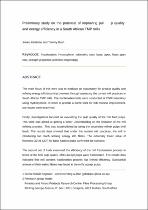 ResearchSpace
ResearchSpace
Preliminary study on the potential of improving pulp quality and energy efficiency in a South African TMP mills
JavaScript is disabled for your browser. Some features of this site may not work without it.
- ResearchSpace
- →
- Research Publications/Outputs
- →
- Journal Articles
- →
- View Item
| dc.contributor.author |
Johakimu, Jonas K

|
|
| dc.contributor.author |
Bush, T

|
|
| dc.date.accessioned | 2010-09-29T14:54:36Z | |
| dc.date.available | 2010-09-29T14:54:36Z | |
| dc.date.issued | 2010-03 | |
| dc.identifier.citation | Johakimu, J and Bush, T. 2010. Preliminary study on the potential of improving pulp quality and energy efficiency in a South African TMP mills. TAPPSA Journal, Vol. 2, pp 1-16 | en |
| dc.identifier.uri | http://www.tappsa.co.za/html_index_links/html_issue_mar_10/TMP%20Mill%20case%20study.html | |
| dc.identifier.uri | http://hdl.handle.net/10204/4419 | |
| dc.description | Copyright: 2010 TAPPSA | en |
| dc.description.abstract | The main focus of this work was to evaluate an opportunity for product quality and refining energy efficiency improvement through assessing the current mill practices in South African TMP mills. The fractionation trials were conducted at a CSIR laboratory using Hydrocyclone. In order to provide a framework for mill process improvement, two issues were examined. Firstly, investigations focused on evaluating the pulp quality of the mill feed pulps. This work was aimed at getting a better understanding on the limitation of the mill refining process. This was accomplished by using the secondary refiner pulps (mill feed). The results data showed that under the current mill practices, the mill is introducing too much refining energy into fibres. The extremely lower value of freeness (32 ml CSF) for base fraction pulps confirmed the scenario. The second set of trials examined the efficiency of the mill fractionation process in terms of the final pulp quality. The mill’s accept pulps were fractionated. The results data indicated that the mill screens’ fractionation process has limited efficiency. A substantial amount of thick walled fibres was found in the mill’s accept pulps. Approximately 66% by mass of the mill’s accept pulps (from the 0.18 mm slotted screens) showed freeness higher than 250 ml CSF. This has a potentially negative effect on the product quality. Our preliminary study has proved that there is significant potential for Hdrocyclone fractionation in this process. This will lead to energy savings due to less intensive main line refining. In addition, the product quality will be improved due to fewer thick walled fibres and less fines in the final pulp. Fewer fines will lead to better dewatering | en |
| dc.language.iso | en | en |
| dc.publisher | TAPPSA | en |
| dc.subject | Fractionation | en |
| dc.subject | Hydrocylone | en |
| dc.subject | Volumetric ratio | en |
| dc.subject | Apex | en |
| dc.subject | Mass apex rate | en |
| dc.subject | Strength properties | en |
| dc.subject | Fibre morphology | en |
| dc.title | Preliminary study on the potential of improving pulp quality and energy efficiency in a South African TMP mills | en |
| dc.type | Article | en |
| dc.identifier.apacitation | Johakimu, J. K., & Bush, T. (2010). Preliminary study on the potential of improving pulp quality and energy efficiency in a South African TMP mills. http://hdl.handle.net/10204/4419 | en_ZA |
| dc.identifier.chicagocitation | Johakimu, Jonas K, and T Bush "Preliminary study on the potential of improving pulp quality and energy efficiency in a South African TMP mills." (2010) http://hdl.handle.net/10204/4419 | en_ZA |
| dc.identifier.vancouvercitation | Johakimu JK, Bush T. Preliminary study on the potential of improving pulp quality and energy efficiency in a South African TMP mills. 2010; http://hdl.handle.net/10204/4419. | en_ZA |
| dc.identifier.ris | TY - Article AU - Johakimu, Jonas K AU - Bush, T AB - The main focus of this work was to evaluate an opportunity for product quality and refining energy efficiency improvement through assessing the current mill practices in South African TMP mills. The fractionation trials were conducted at a CSIR laboratory using Hydrocyclone. In order to provide a framework for mill process improvement, two issues were examined. Firstly, investigations focused on evaluating the pulp quality of the mill feed pulps. This work was aimed at getting a better understanding on the limitation of the mill refining process. This was accomplished by using the secondary refiner pulps (mill feed). The results data showed that under the current mill practices, the mill is introducing too much refining energy into fibres. The extremely lower value of freeness (32 ml CSF) for base fraction pulps confirmed the scenario. The second set of trials examined the efficiency of the mill fractionation process in terms of the final pulp quality. The mill’s accept pulps were fractionated. The results data indicated that the mill screens’ fractionation process has limited efficiency. A substantial amount of thick walled fibres was found in the mill’s accept pulps. Approximately 66% by mass of the mill’s accept pulps (from the 0.18 mm slotted screens) showed freeness higher than 250 ml CSF. This has a potentially negative effect on the product quality. Our preliminary study has proved that there is significant potential for Hdrocyclone fractionation in this process. This will lead to energy savings due to less intensive main line refining. In addition, the product quality will be improved due to fewer thick walled fibres and less fines in the final pulp. Fewer fines will lead to better dewatering DA - 2010-03 DB - ResearchSpace DP - CSIR KW - Fractionation KW - Hydrocylone KW - Volumetric ratio KW - Apex KW - Mass apex rate KW - Strength properties KW - Fibre morphology LK - https://researchspace.csir.co.za PY - 2010 T1 - Preliminary study on the potential of improving pulp quality and energy efficiency in a South African TMP mills TI - Preliminary study on the potential of improving pulp quality and energy efficiency in a South African TMP mills UR - http://hdl.handle.net/10204/4419 ER - | en_ZA |





